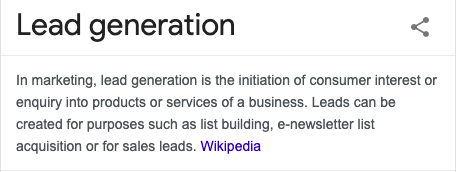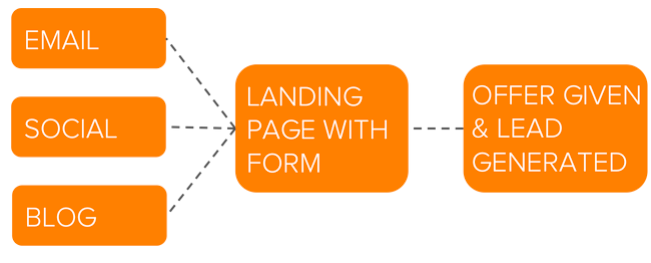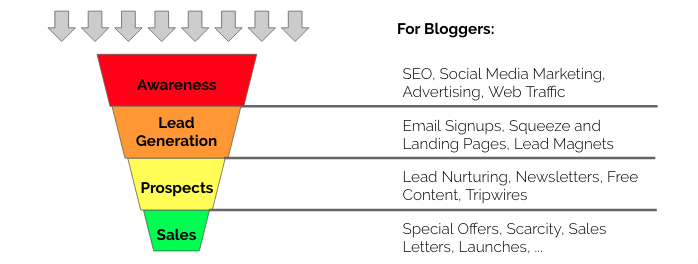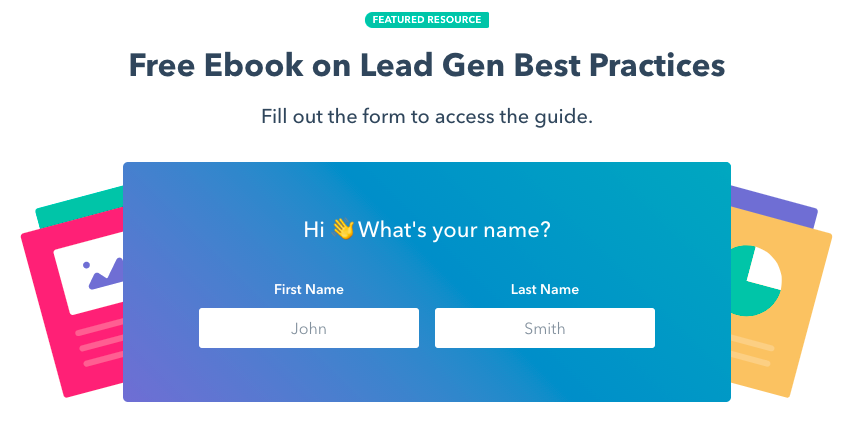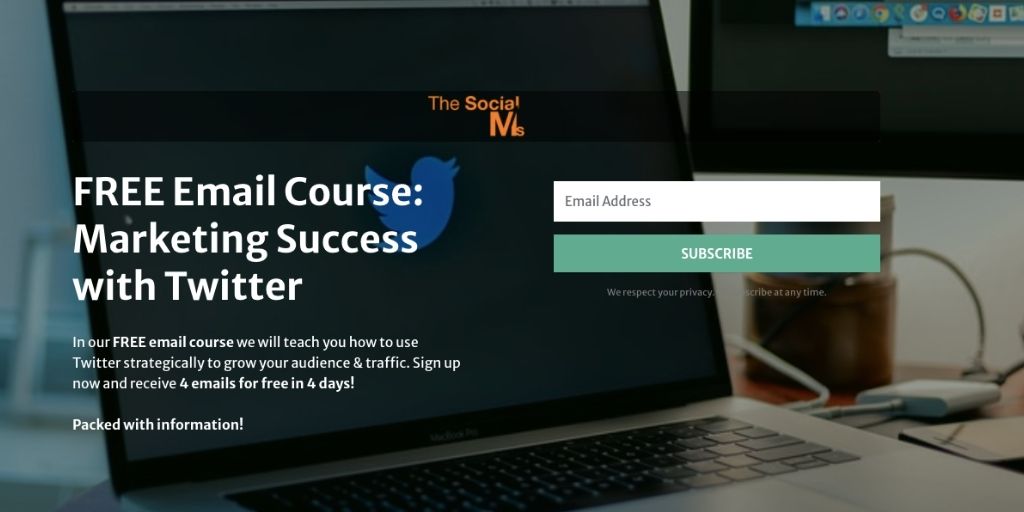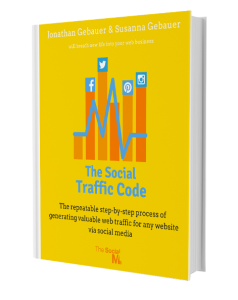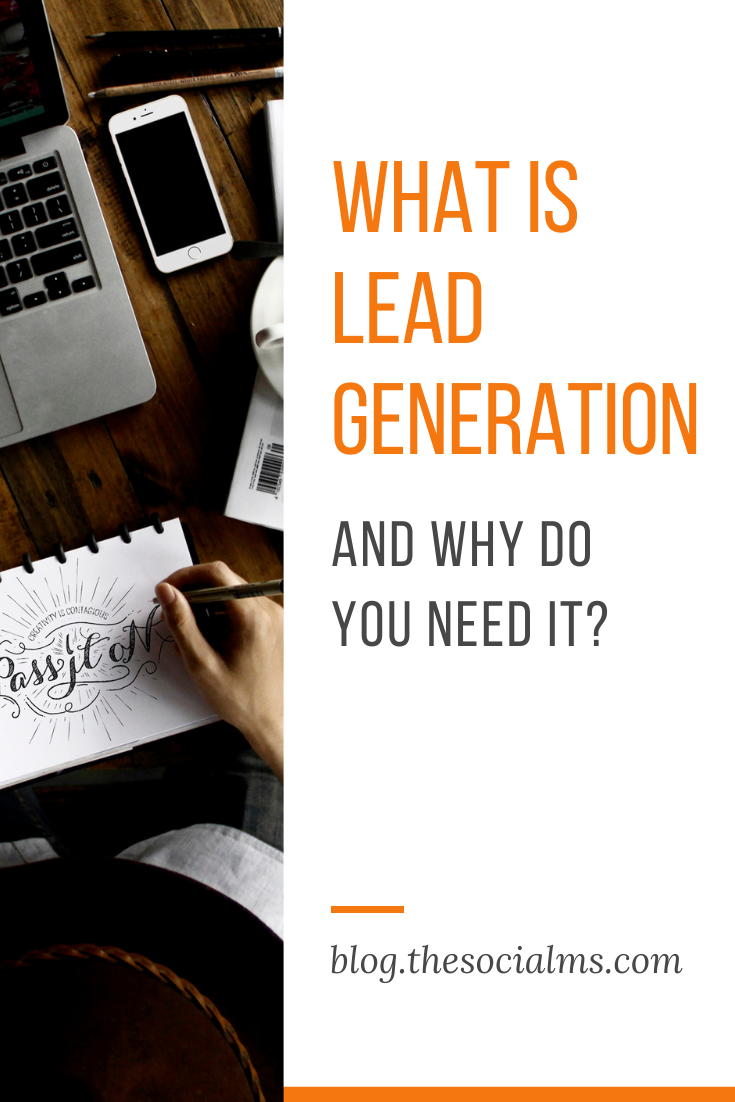When you start a blog or online business, you will have to start your lead generation sooner rather than later. But the first time you come across this term, there remain many questions about what lead generation includes, why you need to do it, and how it is related to email list building, sales funnel, and sales.
Source: Wikipedia
Just in case you want to look up a quick definition of the above terms, check out our list of blogging terms.
Before you read on - we have various resources that show you exactly how to use social networks to gain massive traffic and leads. For instance, check out the following:
FREE Step-by-Step Twitter Marketing GuideFREE Pinterest Marketing Ebook
This post tries to give you some understanding of lead generation and how it will fit your online business.
You will learn why you can never start too early with your lead generation. And that lead generation is more than cold calling or buying a list of contact addresses. 
Let’s start by giving you some explanations for terms that you may be struggling to get straight.
What is a lead?
A lead is a person who may be interested in buying your product at one point in time. A lead is also a prospect. To identify someone as a “lead” usually includes some way of getting or staying in touch with the person.
I am German, as some of you may know. Interesting enough, there is no German word for a “Lead,” so marketers in Germany also refer to a lead as a lead. I loath it since I do not like mixing up the German language with English words as is often done to sound more “expert.” But in the case of “lead” and “lead generation,” I have no solution for the dilemma.
What is lead generation?
Lead generation is the process of finding potentially interested people, getting in touch with them, and making them aware of you and your offer.
Lead generation should include a more sophisticated way of identifying leads than buying a list of random contact addresses.
I often receive offers for services per email, which obviously found my email address either by crawling the web or buying a list – that has nothing to do with generating leads; that is spam!
Lead generation usually also includes staying in touch with the lead to increase interest and the possibility of eventually turning the lead into a customer at some later point in time.
Why do you or your business need lead generation?
The chance that someone buys your product or service at first contact is relatively small. But to stay in touch with prospects, if these prospects are just website visitors that found your site via search engines or social media, is hard.
Hey, before you read on - we have in various FREE in-depth guides on similar topics that you can download. For this post, check out:
FREE workbook: CREATE AWESOME BLOG POSTSFREE Beginner's Guide: START A BLOG
People usually need more than one point of contact before they are ready to buy.
Sure, you can use ads and retargeting to keep them interested.
But lead generation does it better. Whether you research potential leads and identify their interest in a first contact or whether you earn interested leads from website visitors that subscribe to an email list or other forms of address lists: Leads that you identified can be re-contacted, nurtured, and turned into customers in the long run.
Inbound vs. Outbound: What are the different types of lead generation?
There are mainly two types of lead generation: inbound and outbound.
As an entrepreneur, you probably have come across outbound lead generation methods. That’s basically searching for people from your target audience and then getting in touch via phone call, email, or even LinkedIn messaging.
Sometimes this lead generation is very targeted – for instance, when we were still running our publishing platform, agencies called us to ask whether we needed developers, which made sense. At some point in the future, we would have needed more developers to develop the platform’s technology.
But there is also the attempt for lead generation that is rather untargeted. For instance, the catering service calling me on my business phone, offering me the service of lunch meals for my team of 0 employees will not generate much interest because there is zero demand for the offered service on my end.
But that is always the problem with outbound lead generation: You have to make some assumptions about what identifies your target audience, research for people that fulfill your criteria, and get in touch. Sometimes that will be a good match, and sometimes you will fail.
The other way of lead generation is inbound. That is basically what content marketing and blogging do.
The idea behind inbound lead generation is that you do not actively search for leads. Instead, the leads find you or your content, whereas you find the leads in outbound lead generation.
That makes outbound lead generation often much more intrusive than an inbound lead generation – if you fail to find leads at exactly their pain-point.
Inbound leads are targeted via the topics of your content. You create content that is of interest to your target audience. People search for your topics and find you through your content.
The trick with inbound lead generation is to get visible enough in your target group with content that speaks to your target audience so that these potential leads come to your website.
But your inbound lead generation is not done when you got the people to your website. Now you have to turn website visitors into leads.
That is why you need some kind of lead capturing system on your website. This lead capturing system can be a newsletter signup form. It can also be a quiz, a survey, or a piece of free content you offer in exchange for email addresses.
The most straightforward lead capturing system is a signup form for your newsletter. That is the minimum you will need on your website, or your inbound lead generation is doomed.
Image Source: Convince & Convert Blog
The inbound lead generation process then goes like this:
- A website visitor comes to your blog, content, or website. The number of website visitors in a time span is called web traffic. Sources that will lead visitors to your website include social media, search engines, email, and (if you are willing to pay for website visitors) advertising.
- A website visitor takes action on your website and identifies himself as a lead by submitting some contact information – usually an email address. It is up to you to offer website visitors enough incentive to take action and qualify as a lead.
- Now a lead nurturing process should start. You can set up this process as a welcome sequence that automatically starts whenever a new lead qualifies.
Image source: Hubspot
Lead generation in digital marketing
In digital marketing, lead generation often is equal to generating subscribers for an email list and setting off some lead nurturing automation. This can be an email automation welcome sequence.
Another form of lead generation in digital marketing would be to offer a product demo, free consulting, or something similar that is closely connected to your offer and hopefully will make potential customers get in touch with you.
Once a website generates a considerable amount of traffic, the complete lead process can be automated from the moment someone visits a website, uses a signup form, setting off an email automation lead nurturing series, and closing it off with an offer that leads to a sales page.
Lead generation and the sales funnel
Lead generation is the first step in the sales funnel. It is usually followed by a phase of lead nurturing and results in some form of sales offer.
What is a Lead Magnet?
A lead magnet is a piece of valuable content offered on a website in exchange for an email address or other contact information. A lead magnet may also be called a freebie.
What is Lead Nurturing?
The process of building trust and increasing the chance of a lead turning into a customer is called lead nurturing.
Lead nurturing usually involves sending emails that include useful information, testimonials, success stories, or more free content like ebooks, cheat sheets, and workbooks.
What is Lead Scoring?
Some of your leads will be closer to buying from you than others. With lead nurturing, you are trying to move leads along the customer journey closer to make the leap and buying from you.
To help you identify the leads that are most likely to buy and make targeted offers to these hot leads, you can use a system called lead scoring. Lead scoring distributes scores for any action a lead in your list takes on the emails you send them or the phone calls you make to them.
For instance, a lead can score some points by opening an email. The lead will get more points if he clicks on a link in an email or downloads some free content you send him. Over time some leads score far more points than others. These are the ones most likely to turn into customers.
This way, you can identify the leads in your list that interact the most with your content as the ones with the highest scores.
If this still sounds a little confusing, you can check out this educational video about lead scoring from Hubspot:
Examples of lead generation strategies
The most common lead generation tactic is to include signup forms for your email list on your website. But there are more advanced lead generation tactics that you can use to boost your led generation.
Here are some examples.
Free Content
You probably know these offers: You can download a guide, an ebook, a checklist – all you have to do is to enter your email address, and you get the freebie straight to your inbox.
These are probably the most used lead magnets. They are easy to create, and most email marketing tools come with some integrations that allow you to easily offer the lead magnet on your website or blog.
Image Source: Hubspot
The better your offered freebie matches the needs of your target group, the better targeted are the leads you earn this way.
Webinars
A webinar can be used as free content. If you offer the webinar on your website similar to the above freebie offer, you can treat the people joining the webinar as leads.
But a webinar gives you more options. Many service or tool providers partner with other bloggers for webinars. The blogger hosts the webinar and welcomes the tool provider as a guest. The guest does the primary teaching in the webinar – this way, the host does not have much work but provides the audience with value.
The “guest” who does the primary teaching in the webinar can reach the hosting blogger’s audience with the webinar. In exchange, the host usually earns some affiliate commissions for all sales generated in the webinar.
You can also partner with other bloggers and exchange a webinar promotion: You market a webinar of another blogger to your email list, and the other blogger in exchange promotes your webinar to their email list.
You can also market the webinar on your social media channels and even use advertising or remarketing to get more people to your webinar.
Free Online Courses
The easiest version of a free course as a lead generation tactic is an email course. After signup, you start sending a couple of emails with tips on the promised topic to your new subscribers. The email course, in this case, takes over the place of an email welcome automation series.
Courses are awesome for lead generation. They allow you to build trust and show your expertise while at the same time guiding your new leads towards the benefits of your product that you want to sell. The emails you send include exactly the information that your lead signed up for.
Here is the offer for our 4 days, 4 emails Twitter marketing course – you can join today:
Free Product demo
A free product demo can also be used as a lead generation tactic. But this will only work if you can offer high value to your new leads with the demo.
For instance, a tool for signup integration on your website can offer you a demo of how you can best use the tool and how to A/B test various lead generation tactics. This product demo can offer tremendous value to new bloggers who are not (yet) familiar with signup options. Simultaneously, the leads are presented with the awesome solution of this tool for their lead generation.
Some of these lead generation strategies do not necessarily need your website. You can also promote them on social media, email, cooperate with other entrepreneurs to reach more people.
Final Words On Lead Generation
Generating leads is a crucial step in your online business. Lead generation turns website visitors into prospects – and eventually help you make a sale.
Yes, you make a small buck from your website visitors without turning them into leads. But the big money of online businesses always includes lead generation, lead nurturing, and turning leads into customers.
Don’t wait any longer; you need to start your lead generation today!
So you have a blog? Great!
Do you have an audience? A little one? It’s a start!
If you want to double your traffic in a few short weeks, check out our ebook “The Social Traffic Code!”
We have been struggling, trying everything we could think of and nothing worked. Until one day we found the solution. And what should I say? Our first business grew to 500k pageviews per months all with free traffic generation tactics that did not involve any advertising.
And what is best about this strategy? It works not only for us: it works for you, too!
Are you interested? Check out “The Social Traffic Code!”


